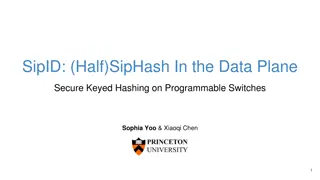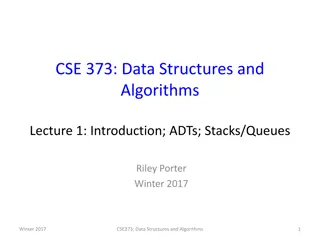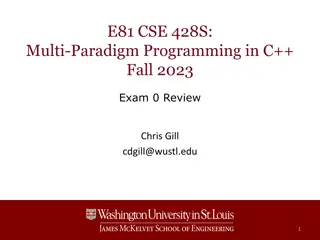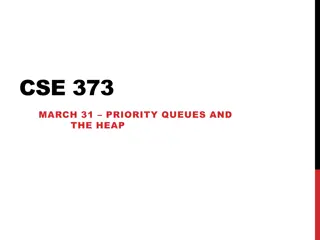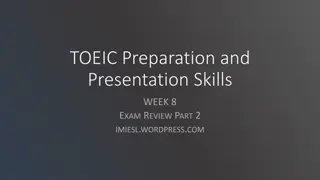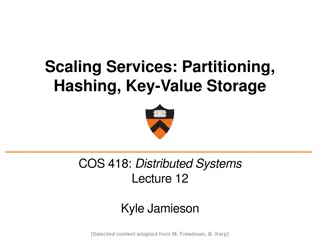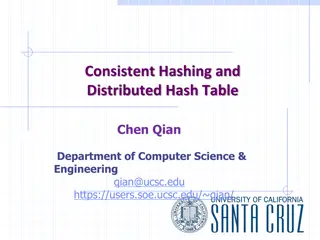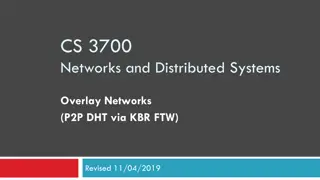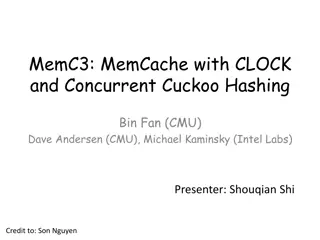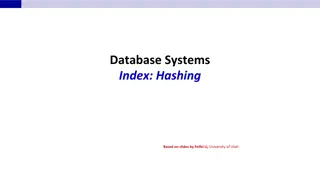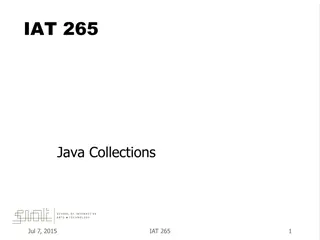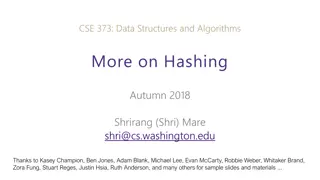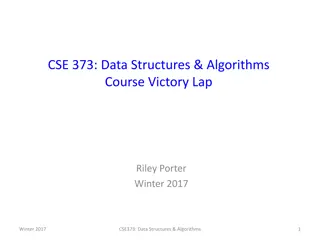CSE 373 - Hashing Concepts and Exam Preparation
Introduction to hashing in CSE 373, covering basic concepts, hash functions, collision resolution, and runtimes. Exam details for Friday's practice exam include topics on Stacks, Queues, BigO Notation, Heaps, Trees, Design Tradeoffs, and exam format with emphasis on theoretical understanding. Lectures on hashing, ideal data structures, difficulties, memory management with hash tables, and implementation methods are discussed.
Download Presentation

Please find below an Image/Link to download the presentation.
The content on the website is provided AS IS for your information and personal use only. It may not be sold, licensed, or shared on other websites without obtaining consent from the author.If you encounter any issues during the download, it is possible that the publisher has removed the file from their server.
You are allowed to download the files provided on this website for personal or commercial use, subject to the condition that they are used lawfully. All files are the property of their respective owners.
The content on the website is provided AS IS for your information and personal use only. It may not be sold, licensed, or shared on other websites without obtaining consent from the author.
E N D
Presentation Transcript
CSE 373 APRIL 24TH HASHING
EXAM FRIDAY Practice exam after class today Topics: Stacks and Queues BigO Notation and runtime Analysis Heaps Trees (BST and AVL) Traversals Design Tradeoffs
EXAM FRIDAY Format No note sheet One section of short answer 4-5 Technical Questions 1 Design Decision Question Less than 10 minutes per problem
EXAM FRIDAY No Java material on the exam Looking for theoretical understanding Explanations are important (where indicated) If you get stuck on a problem, move on Any questions?
TODAYS LECTURE Hashing Basic Concept Hash functions Collision Resolution Runtimes
HASHING Introduction Suppose there is a set of data M Any data we might want to store is a member of this set. For example, M might be the set of all strings There is a set of data that we actually care about storing D, where D << M For an English Dictionary, D might be the set of English words
HASHING What is our ideal data structure? The data structure should use O(D) memory No extra memory is allocated The operation should run in O(1) time Accesses should be as fast as possible
HASHING What are some difficulties with this? Need to know the size of D in advance or lose memory to pointer overhead Hard to go from M -> D in O(1) time
HASHING Memory: The Hash Table Consider an array of size c * D Each index in the array corresponds to some element in M that we want to store. The data in D does not need any particular ordering.
THE HASH TABLE How can we do this? D M
THE HASH TABLE How can we do this? Unsorted Array Apple D M
THE HASH TABLE How can we do this? Unsorted Array Apple Pear D M
THE HASH TABLE How can we do this? Unsorted Array Apple Pear Orange D M
THE HASH TABLE How can we do this? Unsorted Array Apple Pear Orange Durian D M
THE HASH TABLE How can we do this? Unsorted Array Apple Pear Orange Durian Kumquat D M
THE HASH TABLE What is the problem here? Takes O(D) time to find the word in the list Same problem with sorted arrays! Apple Pear Orange Durian Kumquat D M
THE HASH TABLE What is another solution? Random mapping Kumquat Pear D Durian M Apple Orange
THE HASH TABLE What s the problem here? Can t retrieve the random variable, O(D) search! Kumquat Pear D Durian M Apple Orange
THE HASH TABLE What about a pseudo-random mapping? This is the hash function Kumquat Pear D Durian h(x) M Apple Orange
HASH FUNCTIONS The Hash Function maps the large space M to our target space D. We want our hash function to do the following: Be repeatable: H(x) = H(x) every run Be equally distributed: For all y,z in D, P(H(y)) = P(H(z)) Run in constant time: H(x) = O(1)
HASH EXAMPLE Let s consider an example. We want to save 10 numbers from all possible Java ints What is a simple hash function? 0 1 2 3 4 5 6 7 8 9 h(x) = key%10 ints
HASH EXAMPLE Let s insert(519) table Where does it go? 519%10 = 0 1 2 3 4 5 6 7 8 9 h(x) = key%10 ints
HASH EXAMPLE Let s insert(519) table Where does it go? 519%10 = 9 0 1 2 3 4 5 6 7 8 9: 519 519 h(x) = key%10
HASH EXAMPLE Insert(204) 0 1 2 3 4 5 6 7 8 9: 519 204 519 h(x) = key%10
HASH EXAMPLE Insert(204) 0 1 2 3 4: 214 5 6 7 8 9: 519 204 519 h(x) = key%10
HASH EXAMPLE insert(1001) 0 1 2 3 4: 214 5 6 7 8 9: 519 204 519 h(x) = key%10 1001
HASH EXAMPLE insert(1001) 0 1: 1001 2 3 4: 214 5 6 7 8 9: 519 204 519 h(x) = key%10 1001
HASH EXAMPLE Is there a problem here? 0 1: 1001 2 3 4: 214 5 6 7 8 9: 519 204 519 h(x) = key%10 1001
HASH EXAMPLE Is there a problem here? insert(3744) 0 1: 1001 2 3 4: 214 5 6 7 8 9: 519 204 519 h(x) = key%10 1001 3744
HASH EXAMPLE Is there a problem here? insert(3744) 0 1: 1001 2 3 4: 214 5 6 7 8 9: 519 204 519 h(x) = key%10 1001 3744
HASH EXAMPLE Is there a problem here? insert(3744) This is called a collision! 0 1: 1001 2 3 4: 214 5 6 7 8 9: 519 204 519 h(x) = key%10 1001 3744
HASH EXAMPLE How to rectify collisions? Think of a strategy for a few minutes Possible solutions: Store in the next available space Store both in the same space Try a different hash Resize the array
LINEAR PROBING Consider the simplest solution Find the next available spot in the array This solution is called linear probing 0 1: 1001 2 3 4: 204 5: 3744 6 7 8 9: 519 204 519 h(x) = key%10 1001 3744
LINEAR PROBING What are the problems with this? How do we search for 3744? Need to go to 4, and then cycle through all of the entries until we find the element or find a blank space What if we need to add something that ends in 5? It also ends up in this problem area This is called clustering
CLUSTERING What are the negative effects of clustering? If the cluster becomes too large, two things happen: The chances of colliding with the cluster increase The time it takes to find something in the cluster increases. This isn t O(1) time!
CLUSTERING How can we solve this problem? Resize the array Give the elements more space to avoid clusters. How long does this take?O(n)! all of the elements need to be rehashed. Store multiple items in one location This is called chaining We ll discuss it after the midterm
HASH TABLES Take-aways for the midterm Hashtables should provide O(1) dictionary operations Collisions make this problem difficult to achieve Hashtables rely on a array and a hash function The array should be relative to the size of the data you want to keep The hash function should run in constant time and should distribute among the indices in the target array Linear probing is a solution for collisions, but only works when there is lots of free space Resizing is very costly
NEXT CLASS Hash Tables Examples, examples, examples No new theory Exam review

 undefined
undefined







